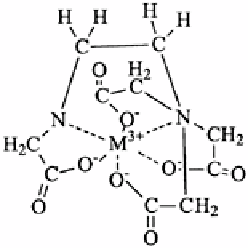Environmental Engineering Reference
In-Depth Information
groups are benzene rings with an -OH group. Both acid and phenol groups can ionize,
leaving a negative charge on the group and thus attracting cations.
Another mechanism of attraction is through its oxygen-containing groups, by which
humus can hold metal cations in structures resembling chelates, as shown in Figure 9.6.
(Chela is Latin for crab.) In this case association with lone pairs of electrons on oxygen
and nitrogen hold the metal. The term chelate indicates that there are several parts of one
organic
FIGURE 9.6
Ethylenediaminetetraacetic acid with a chelated metal ion (M+).
compound involved in the association. An example of a simple organic chelate is
ethylenediaminetetraacetic acid (EDTA). In this case the functional groups act like claws
associated with the metal. Humus also has a high affinity for metals and holds them by
both cation exchange and chelation mechanisms. These mechanisms hold metals in forms
that are available to plants [22, 23].
9.4.
THE BIOCHEMICAL COMPONENT
In addition to simple and complex organic compounds, soil also contains compounds that
are biochemical. These occur from two different sources. First, many organisms exude
enzymes to decompose compounds outside the cell. In most if not all cases this is done so
that molecules that are too large to bring inside the cell for digestion can be broken down.
For instance, cells cannot use cellulose until it is broken down into its individual sugar
monomers (e.g., fungi), which are the primary cellulose degraders and exude
extracellular enzymes, cellulases, to break down cellulose.
Extracellular enzymes are most often discussed as being exuded by microorganisms;
however, there is evidence that they are also exuded by plants and even some animals.
Plant roots have been shown to exude the enzymes invertase, phosphoratase, and
amylase. Animals, particularly earthworms, have been shown to contribute invertase to
the soil solution. This is similar to our secreting invertase in saliva to break down starch
to sugar in our mouths. Little is known about the overall importance of animal-released
enzymes in soil, however.
Extracellular enzymes are of particular interest because of their involvement in soil

Search WWH ::

Custom Search